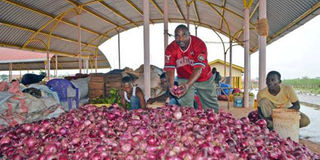Tanzanian farmers reap big from food market in Nairobi

An onion trader at the new Taveta market close to the Kenya-Tanzania border in April. Most of the traders get their supplies from Tanzania.
What you need to know:
- Most of the onions are grown in the remote irrigated fields of Mang’ola, about 200 kilometres west of Arusha.
Due to the high demand and reliable market overseas, Kenyans have virtually taken over the farms through contract farming.
Under the arrangement, Kenyan investors hire farmers to grow onions and even supply inputs such as fertiliser.
ARUSHA
One might have easily attributed the long queues of trucks awaiting to enter Kenya at the Namanga border town last Tuesday to the cumbersome Customs procedures.
For some reason, they attracted the attention of a Tanzanian Cabinet minister who was on an official visit to the ever busy border town.
So she enquired why so many trucks were heading to Kenya, with no significant number lining up to enter Tanzania.
The border officials swiftly informed the Health minister, Ms Ummy Mwalimu, that they were loaded with maize and other foodstuff for the Kenyan market, where demand is high.
For the residents of Namanga, it is common to see trucks heading to Kenya loaded with fresh farm produce, while those entering Tanzania are filled with processed goods and merchandise.
Food from Tanzania easily finds its way into Kenya although the two East African Community states have not sorted out their trade disputes over confectioneries.
“There are virtually no restrictions, except those pertaining to the quality of the products,” said Mr Walter Maeda, chairman of the Arusha Chapter of the Tanzania Chamber of Commerce, Industry and Agriculture (TCCIA).
Tanzania also exports food to Kenya through the Holili/Taveta, Horohoro/Lunga Lunga and Tarakea/Loitokitok borders.
Mr Maeda said Tanzanian producers are driven by the good prices in Kenya due to the high demand for food.
KENYAN INVESTORS
He, however, lacks statistics because the cross-border food trade is largely informal.
The Arusha hotelier singled out onions among the leading commodities consistently exported to Kenya because, unlike maize, they are not affected by drought.
“Our onions are preferred by Kenyan traders, who pack them in Nairobi and export overseas,” he said.
Most of the onions are grown in the remote irrigated fields of Mang’ola, about 200 kilometres west of Arusha. Due to the high demand and reliable market overseas, Kenyans have virtually taken over the farms through contract farming.
Under the arrangement, Kenyan investors hire farmers to grow onions and even supply inputs such as fertiliser.
At some point, this arrangement drew the ire of local politicians. But senior government officials urged farmers not to lose export opportunities for their surplus produce.
BORDER POSTS
Recently, Agriculture minister Japhet Hasunga was quoted as saying that the country plans to export 100,000 tonnes of its surplus produce to Kenya, Rwanda, Burundi and Malawi.
The exports are assured because an assessment last December revealed that there were adequate stocks. About 3.2 million of the 16.8 million tonnes of food produced during the 2018/2019 season was surplus.
With the introduction of the one-stop border post in Namanga initiated by the EAC, business is now smooth, regulated but mostly in terms of quality.
The products undergo moisture content and radiation tests, although some exporters are bothered by the number of institutions that do the clearance.
Tanzania also exports livestock to Kenya, with about 300 head of cattle sold through the Namanga area alone every month.
“But there is little control over livestock exports. Most are driven across the official or unofficial border posts,” an official said.





